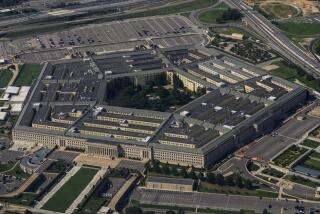SEALs Usually Are Where the Action Is
- Share via
When U.S. officials decided to topple Panamanian dictator Manuel Noriega, the Navy SEALs were chosen to prevent him from escaping the country last December. SEALs, sea-air-land commandos, crippled Noriega’s private jet and snuck into a tightly guarded harbor to disable his high-speed patrol boats.
The price of such stealthy missions, however, is steep. Of the 4,150 special forces members involved in Operation Just Cause, 11 were killed and more than 200 were wounded. Among the rest of the 27,000 troops involved, there were 21 deaths and more than 200 wounded.
“War is a vicious, cruel endeavor and SEALs are in the harshest, cruelest portion of any war. In the Navy, there is the captain of a ship in his nice, white uniform and, at the other end of the spectrum, there is the SEAL. We need them both,” said retired Rear Adm. Gene La Rocque, director of the Center for Defense Information in Washington. “SEALs are a special breed; personally, I think they are a little nuts, but I am glad they are willing to do it.”
For SEALs, the mission is unconventional warfare. And the range of skills is vast: from demolition to free fall parachuting, from diving to desert survival. While most branches of the military face shrinking budgets, Navy SEALs and other Special Operation Forces are increasing in size.
“If you put Operation Desert Shield aside, we will be back to having to deal with terrorism, insurgencies, narco-terrorism, and instability in Third World countries--those problems do not yield to the threat of nuclear force,” said Seth Cropsey, principal deputy assistant secretary of defense. “People have known for a long time that small wars, or what is called low-intensity conflicts, is the way we are going to be fighting.”
In Panama, as well as Grenada, SEALs were the first to sneak into enemy territory. Though unwilling to provide details of the efforts, officials said SEALs also are expected to play a role in the current Middle East crisis.
“Marines always advertise that they are the first ashore. But if our guys weren’t first on shore, Marines couldn’t get there,” said Lt. Cmdr. Tom Campbell, the SEAL training officer at Coronado’s Naval Special Warfare Command.
SEALs are a small, elite community. SEAL teams 1, 3 and 5, as well as training, are based in Coronado, while teams 2, 4, 6 and 8 are East Coast-based. Their ranks include 1,547 enlisted men and 455 officers, a 72% increase in size from five years ago. And they are expected to keep growing.
In 1981, $441 million was allocated to special operation forces; the Navy received $93 million. In 1990, special operation forces received $2.8 billion; the Navy’s share was $333 million.
Sea-air-land teams began in 1943 with volunteers culled from the Naval Construction Battalions. Just before the invasion of Sicily, they were assigned to prepare the beach for the arrival of an amphibious battle group. Months later, formal training in combat and underwater demolition was established.
Because of the war, training efforts were accelerated. An intense period was called “Motivation Week.” Today that period is known as “Hell Week.”
Those who survive Hell Week come away with a sense of brotherhood.
“We do everything as a team,” one instructor said. “The guys you put through training are going to be standing next to you one day on a mission--I know that.”
And Hell Week also offers a boost of self-confidence, officials said.
“It tells the men something they would not have otherwise known--that they can take an extraordinary amount of abuse,” said Cropsey, who oversees Special Operations and Low Intensity Conflict. “If they can go through that, they can go through anything.”
SEAL applicants must be male, younger than 28 (unless they get a waiver), and be fit enough to pass several physical tests.
Before beginning SEAL training, or Basic Underwater Demolition (BUDs), applicants undergo four to six weeks of fitness training. BUDs training itself is divided into three phases. The first phase, which is nine weeks long, continues fitness training and developes basic combat skills. Hell Week occurs in the sixth week of first phase training.
Land warfare, weapons and demolitions are the focus of the second phase, also nine weeks long. In the third 7-week phase, students learn and polish diving techniques. And finally, BUDs graduates receive three weeks of parachute training. About 50% of all trainees finish the entire program.
SEAL trainees can quit the program at any time. Officials recently discarded the long-held tradition of having a man ring a bell to signal that he quit. Today, individuals who wish to drop out of the program are first counseled by several officers.
While the program is deemed the most rigorous in the armed forces, experts say it is not more than a fit person can handle.
“For individuals without any underlying medical problem, it’s astounding how much the body can go through,” said Bill Haskell, a professor of medicine at Stanford University School of Medicine, who specializes in physical activity and performance research.
“For the kinds of risks these individuals may be placed at in the future, you have an obligation to try to screen out those who say they want to do this and just aren’t able to withstand it.”
More to Read
Sign up for Essential California
The most important California stories and recommendations in your inbox every morning.
You may occasionally receive promotional content from the Los Angeles Times.













